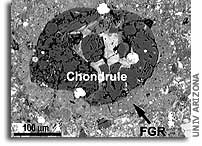Shock Waves Through the Solar Nebula Could Explain Water-Rich Space Rocks

Shock waves through icy parts of the solar nebula could well be the
mechanism that enriched meteorites with water — water that some believe
provided an otherwise dry Earth with oceans, according to a new study
published in the current issue of Science (Jan. 24).
Scientists have long debated how “chondrules” might have formed. Chondrules
are millimeter-sized blobs of once-melted minerals found within chondritic
meteorites, which are thought to be the oldest objects in the solar system.
In some of these meteorites, chondrules are rimmed by fine silicate dust
particles that have reacted with water.
Researchers at first speculated that chondrules and their water-rich rims
formed when water molecules in the solar nebula collided with dust. But a
1987 study dispelled that idea, because the time it would take for the
minerals to form in this manner would be longer than the lifetime of the
solar nebula.
Planetary scientists at the University of Arizona and University of Hawaii
now report that chondrule-forming shock waves in icy regions of the nebula
could have produced conditions that allowed rapid mineral hydration. Fred J.
Ciesla, Dante S. Lauretta and Lon L. Hood of the UA and Barbara Cohen of the
UH collaborated in the study.
Lauretta and Cohen speculated years ago that a big energetic event, like a
shock wave, might produce enough energy to vaporize ice particles and
briefly create conditions that made such quick hydration reactions possible.
Ciesla modeled the scenario of what happened to particles of silicate and
ice during a shock wave event.
“And what happens is, the ice particles vaporize in this very energetic
event, producing high water vapor pressure. During this brief period of
increased water pressure, the hydration reaction occurs much faster than
previously predicted,” Ciesla said. “During this brief period, the
chondrules melt and the rims form in the same event.”
Gas slows as it passes through a shock front, increasing in temperature and
density. But solid particles entrained in the gas continue through the shock
wave at high velocity. “The solid particles heat up because they are
speeding through the slower-moving gas. And just as a meteor is heated up
and burns when it enters Earth’s atmosphere, particles are heated when they
collide with the gas molecules. Gas both heats and slows the chondrules, so
they melt and begin to cool. The water vapor then reacts with the dust to
form these hydrated silicates, and the chondrules accrete these silicates to
form their rims.”
“An interesting characteristic of these particular meteorites is that they
contain a lot of water, and the deuterium-to-hydrogen ratios in that water
matches the ratios we find in Earth’s water,” Ciesla noted.
Why Earth has water is a mystery, for “especially early on in the solar
nebula, the area where the Earth formed was too hot for water to incorporate
into a solid body,” Ciesla said. Meteorites may have delivered at least part
of Earth’s water, although that remains open to debate, he added.
The scenario also suggests how so much organic material has survived in the
carbonaceous chondrite meteorites. If water reacted with the fine dust in
the solar nebula as the new research suggests, temperatures in the
meteorites would have remained low enough for organic molecules to survive
and be delivered, along with water, to Earth.
Although the idea that shock waves formed the hydrated rock and chondrules
found in the most primitive meteorites stands up to quantitative analysis,
scientists are still speculating about where the shock waves come from, and
it’s a topic Ciesla hopes to address in this doctoral thesis.
UA planetary scientist Lon Hood, one of the authors on the Science paper,
originally theorized that as Jupiter was forming, it excited the orbits of
the many “planetismals,” or planet building-blocks, in the region that
became the present day asteroid belt so that they were propelled through the
gas in the solar nebula at speeds greater than the speed of sound, creating
shock waves. Ciesla has begun testing that idea.
Other ideas on the origin of shock waves also involve Jupiter is some way,
he said.
IMAGE: A high-resolution electron image of a chondrule surrounded by a rim
of fine-grained dust that has reacted with water can be downloaded at
http://www.lpl.arizona.edu/~fciesla/figs/fig1.tif
The image, courtesy of Dante Lauretta, appears in the Science article.









